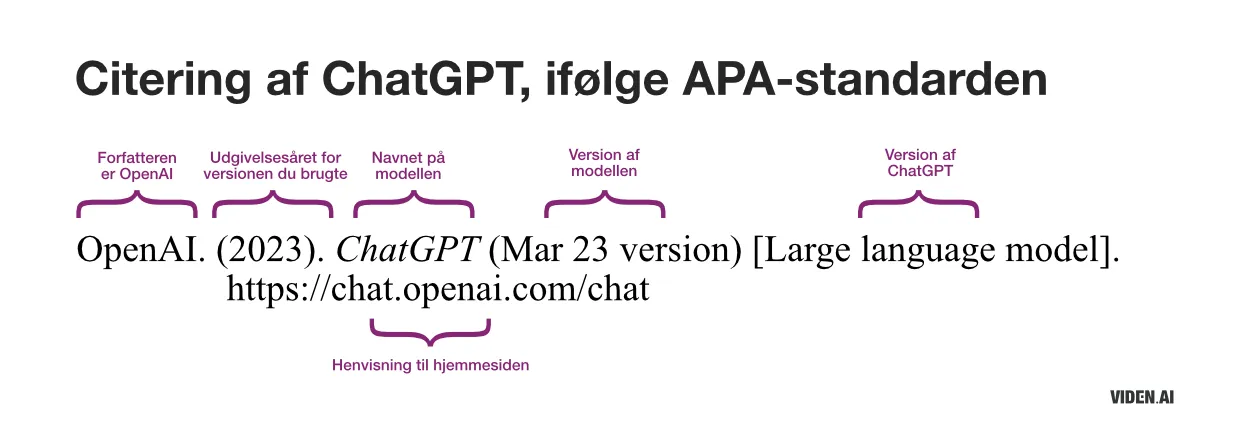On April 7, 2023, the American Psychological Association (APA) released guidelines on citing generative AI (artificial intelligence that generates new texts, images, videos, data, etc.). The APA standard is an internationally recognized reference system with some rules for how sources are referred to in texts and how a bibliography is designed.
In this article, we'll review the new guidelines for citing texts written by generative AI, but there's also a link at the bottom to the MLA standard.
For example, SDU writes to their students: "SDU points out that it is not allowed to use chatbots, including "ChatGPT", in connection with exams and teaching activities unless their use is specifically listed as a direct part of the exam or teaching activity." https://sdunet.dk/en/undervisning-og-eksamen/nyheder/nyheder_om_uddannelse/20221221_chatbot
You should cite generative AI when you:
- Prafraseing a text that a generative AI has written.
- Quote or use content created by a generative AI in your work (text, images, data, video, or other).
- has used the tool e.g. idea generation, transcription or literature search.
Before you start making source references, you must describe how generative AI has been used in the method section of the assignment.
ChatGPT and the APA standard
The big challenge of quoting ChatGPT is that others can't recreate the same text from a prompt. At the same time, it cannot be cited as personal communication since there is no person. This means that the text from ChatGPT should be treated the same way as when sharing an algorithm's output.

To quote ChatGPT, you must first specify the prompt used to generate the text and then parts of the text that the language model generated.
ChatGPT's different versions can be identified by name and version numbers. Version 4 is called [Large language model], while other versions may be designated as [ChatGPT-3.5].
When the prompt states, "Why can glucose react with Tollen's reagent while fructose (in theory) cannot?" ChatGPT explains that both glucose and fructose react with Tollen's reagent: "Fructose is a ketone and contains a ketone group instead of an aldehyde group. Theoretically, ketones should not react with Tollen's reagent. But fructose can nevertheless give a positive reaction with Tollen's reagent. This is because, under basic conditions, fructose present in Tollen's reagent can be converted into an aldose, a carbohydrate containing an aldehyde group, by a process called tautomery. The resulting aldose (aldehyde group) can then react with Tollen's reagent." (OpenAI, 2023).
Bibliography:
OpenAI. (2023). ChatGPT (Mar 23 version) [Large language model]. https://chat.openai.com/chat
It is also possible to take out parts of the text that ChatGPT generates and attach the entire text.
In the subsequent prompt "Why is a positive reaction happening?" the response from ChatGPT indicated that "So even if fructose does not directly respond with Tollen's reagent, it can still produce a positive reaction" and that it happens "because it can be converted to an aldose under the reaction conditions." (OpenAI, 2023; see Appendix 1 for the full transcript)
Bibliography:
OpenAI. (2023). ChatGPT (Mar 23 version) [Large language model]. https://chat.openai.com/chat
OpenAI. (2023). ChatGPT (Mar 23 version) [Large language model]. https://chat.openai.com/chat
Reference in brackets:
... which is a great language model (OpenAI, 2023)
Narrative reference:
According to OpenAI (2023), language models will...
Why is it important to be able to cite generative AI?
Texts written by generative AI can help demonstrate a deeper understanding and provide multiple perspectives on the topic being worked on. Quoting ChatGPT shows that it has considered and critically considered the output generated by ChatGPT. In addition, you show that you have assessed whether the information is relevant to your task. However, it is important to correct citations of ChatGPT because it helps ensure academic integrity. At the same time, it allows us to verify the information presented in the task.
The above should not be seen as an opportunity to let ChatGPT write the tasks but as an opportunity to be critical of the output the model comes with. This also makes it possible to process academic content written by artificial intelligence without being accused of cheating. It is important to remember that the information provided by ChatGPT should not be considered the primary source and should, therefore, always be used in conjunction with other sources.
In the link collection below, you can read more about correct source citation in APA, MLA and Chicago.
Sources
https://apastyle.apa.org/blog/how-to-cite-chatgpt














